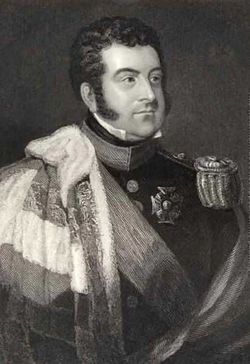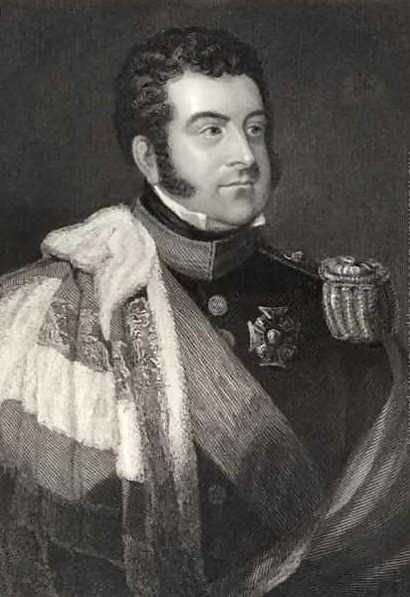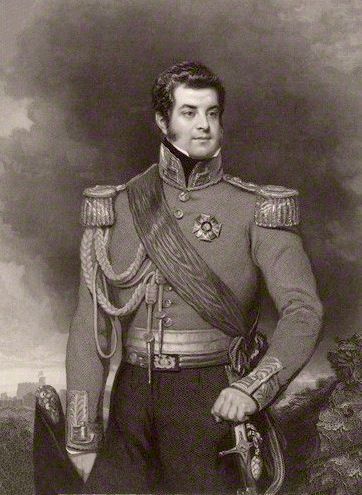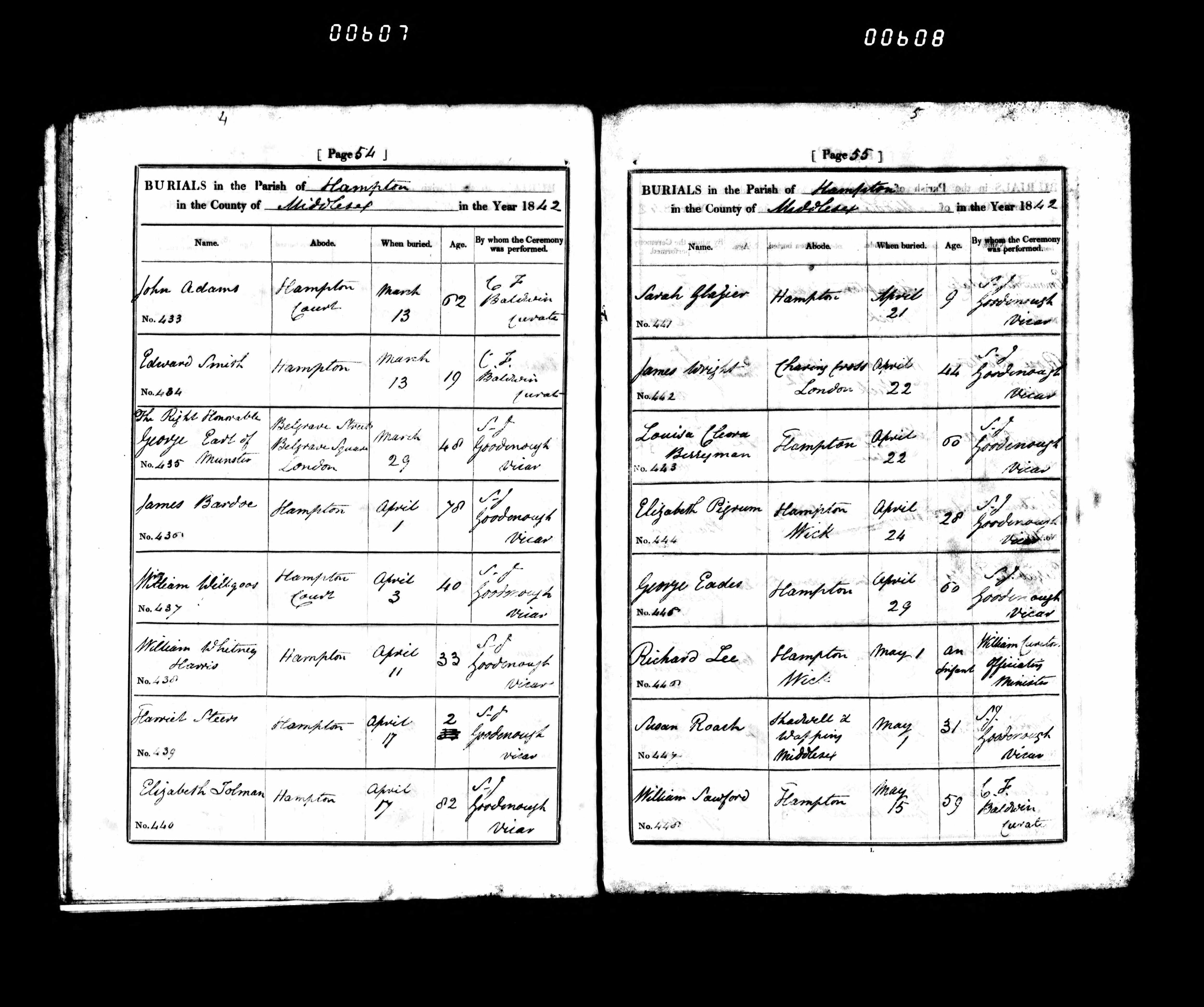He was well-educated. Like his siblings, he had little contact with his mother after his parents separated in 1811, preferring to rely on his expectations from his father. He served as an army officer during the Peninsular War and subsequently in India. He was created 1st Earl of Munster, 1st Viscount FitzClarence and 1st Baron Tewkesbury on 4 June 1831, and made a Privy Councillor in 1833. "Earl of Munster" had been a title held by his father before his accession to the British throne.
George, like his siblings, was dissatisfied with the provisions made for him and this, combined with his increasing mental instability, caused a series of quarrels with his father which ended in a complete breach. The estrangement caused the King great distress, but those close to him thought it better that there be as little contact as possible, since Munster's visits invariably upset his father. Even the death of Munster's sister Sophia de L'Isle, the King's favourite child, in April 1837, did not bring about a reconciliation.
He gained the rank of Major-General in the British Army and held the office of aide-de-Camp to his father King William IV between 1830 and 1837. He held the office of Lieutenant of the Tower of London between 1831 and 1833, was Constable and Governor of Windsor Castle between 1833 and 1842 and aide-de-Camp to Queen Victoria between 1837 and 1841. He was elected president of the Royal Asiatic Society in 1841.
An account of his experiences in the Peninsular War was published in: Memoirs of the Late War: Comprising the Personal Narrative of Capt. Cooke, the History of the Campaign of 1809 in Portugal, by the Earl of Munster, and a Narrative of the Campaign of 1814 in Holland, by T.W.D. Moodie
George married Mary Wyndham (29 August 1792 – 3 December 1842). The daughter of George Wyndham, 3rd Earl of Egremont, and his mistress Elizabeth Fox, on 18 October 1819. at St. Georges, Hanover Square, London. Their union produced seven children.:
1) Lady Adelaide Georgiana FitzClarence (28 August 1820 – 11 October 1883); died unmarried.
2) Lady Augusta Margaret FitzClarence (29 July 1822 – 5 September 1846); married Baron Knut Philip Bonde
3) William George FitzClarence, 2nd Earl of Munster (19 May 1824 – 30 April 1901). married his first cousin Wilhelmina Kennedy-Erskine
4) Hon Frederick Charles George FitzClarence (1 February 1826 – 17 December 1878); married Adelaide Augusta Wilhelmine Sidney
5) Lady Mary Gertrude FitzClarence (ca. 1832 – 1834); died in infancy.
6) Captain Hon George FitzClarence (15 April 1836 – 24 March 1894); married Maria Henrietta Scott (d. 1912)
7) Lieutenant Hon Edward FitzClarence (8 July 1837 – 23 July 1855); unmarried.
George FitzClarence committed suicide at the age of 48 in London. He shot himself with a pistol presented to him by King George IV when Prince of Wales. His suicide came as no surprise to his family who had long been concerned about his mental condition; his father's biographer attributes it to "a paranoiac sense of persecution." At his inquest, his doctor and a surgeon told the coroner that they believed he was going mad, and in recent years there has been speculation that he suffered from the probably hereditary malady of porphyria which had afflicted his grandfather and several other members of the family. He was buried at St. Mary's Church, Hampton on the Thames near Bushy Park.
He was well-educated. Like his siblings, he had little contact with his mother after his parents separated in 1811, preferring to rely on his expectations from his father. He served as an army officer during the Peninsular War and subsequently in India. He was created 1st Earl of Munster, 1st Viscount FitzClarence and 1st Baron Tewkesbury on 4 June 1831, and made a Privy Councillor in 1833. "Earl of Munster" had been a title held by his father before his accession to the British throne.
George, like his siblings, was dissatisfied with the provisions made for him and this, combined with his increasing mental instability, caused a series of quarrels with his father which ended in a complete breach. The estrangement caused the King great distress, but those close to him thought it better that there be as little contact as possible, since Munster's visits invariably upset his father. Even the death of Munster's sister Sophia de L'Isle, the King's favourite child, in April 1837, did not bring about a reconciliation.
He gained the rank of Major-General in the British Army and held the office of aide-de-Camp to his father King William IV between 1830 and 1837. He held the office of Lieutenant of the Tower of London between 1831 and 1833, was Constable and Governor of Windsor Castle between 1833 and 1842 and aide-de-Camp to Queen Victoria between 1837 and 1841. He was elected president of the Royal Asiatic Society in 1841.
An account of his experiences in the Peninsular War was published in: Memoirs of the Late War: Comprising the Personal Narrative of Capt. Cooke, the History of the Campaign of 1809 in Portugal, by the Earl of Munster, and a Narrative of the Campaign of 1814 in Holland, by T.W.D. Moodie
George married Mary Wyndham (29 August 1792 – 3 December 1842). The daughter of George Wyndham, 3rd Earl of Egremont, and his mistress Elizabeth Fox, on 18 October 1819. at St. Georges, Hanover Square, London. Their union produced seven children.:
1) Lady Adelaide Georgiana FitzClarence (28 August 1820 – 11 October 1883); died unmarried.
2) Lady Augusta Margaret FitzClarence (29 July 1822 – 5 September 1846); married Baron Knut Philip Bonde
3) William George FitzClarence, 2nd Earl of Munster (19 May 1824 – 30 April 1901). married his first cousin Wilhelmina Kennedy-Erskine
4) Hon Frederick Charles George FitzClarence (1 February 1826 – 17 December 1878); married Adelaide Augusta Wilhelmine Sidney
5) Lady Mary Gertrude FitzClarence (ca. 1832 – 1834); died in infancy.
6) Captain Hon George FitzClarence (15 April 1836 – 24 March 1894); married Maria Henrietta Scott (d. 1912)
7) Lieutenant Hon Edward FitzClarence (8 July 1837 – 23 July 1855); unmarried.
George FitzClarence committed suicide at the age of 48 in London. He shot himself with a pistol presented to him by King George IV when Prince of Wales. His suicide came as no surprise to his family who had long been concerned about his mental condition; his father's biographer attributes it to "a paranoiac sense of persecution." At his inquest, his doctor and a surgeon told the coroner that they believed he was going mad, and in recent years there has been speculation that he suffered from the probably hereditary malady of porphyria which had afflicted his grandfather and several other members of the family. He was buried at St. Mary's Church, Hampton on the Thames near Bushy Park.
Family Members
-
![]()
Sophia Fitzclarence Sidney
1796–1837
-
![]()
Lady Mary FitzClarence Fox
1798–1864
-
![]()
Lieutenant-General Lord Frederick FitzClarence
1799–1854
-
![]()
Lady Elizabeth Fitzclarence Hay
1801–1856
-
![]()
Rear Admiral Lord Adolphus FitzClarence
1802–1856
-
Augusta FitzClarence Kennedy-Erskine Gordon-Hallyburton
1803–1865
-
![]()
Rev Augustus FitzClarence
1805–1854
-
![]()
Lady Amelia FitzClarence Cary
1807–1858
Advertisement
Explore more
Sponsored by Ancestry
Advertisement


















